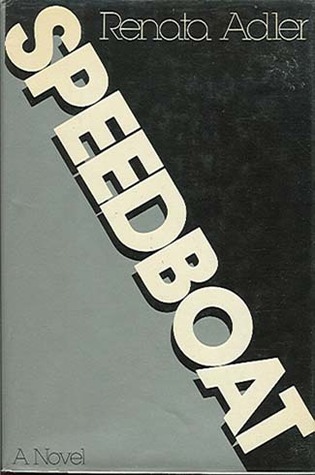As I explained in my last post, this is part of a short series on mosaic novels–novels made up of vignettes that build up to a cumulative theme instead of a single plot. For a lot of people the classic example will be Renata Adler’s Speedboat. Speedboat is a literary cult classic and its recent reprint by New York Review Books Classics got the kind of reviews and attention most new novels only dream of. Most of Speedboat’s vignettes are less than a page long, and many are single paragraphs. They’re written in the voice of Jen Fain, a journalist in the 1970s. Unlike The Book of Disquiet, Speedboat was deliberately ordered, not pulled out of a trunk. It’s also more arch, less introspective, and much more elliptical. According to its afterword, when Adler wrote Speedboat she often found herself stopping before she’d reached a section’s planned ending. The result resembles a book of compact essays suggesting more than they say outright, with a journalist’s eye for telling details.

Speedboat is a portrait of a particular social milieu (white, educated, upper middle class New Yorkers) at a particular time (the early 1970s). Speedboat is dryly funny and self-deprecating (which may be important for some in an age when it’s harder than it used to be to have patience with feckless privilege). I love its specificity. I said this was a book with exactly the right details but it also uses exactly the right words, in exactly the right order. Every page has several perfect sentences and at least one surprising sentence. Some characters who appear for a few paragraphs have enough comic presence to carry stories of their own. Says Jen, “Hardly anyone about whom I deeply care at all resembles anyone else I have ever met, or heard of, or read about in the literature.” (Which is, there, one of those perfect sentences I mentioned: the way “at all” might equally well belong to “care” or “resembles;” the way it doesn’t end with “read about” but with “in the literature” as though she’s checked scientific journals.)
Like The Book of Disquiet, Speedboat allows anecdotes and observations to stand on their own without having to squeeze themselves into a plot. Vignettes don’t have to justify their presence in utilitarian terms to avoid getting cut. The mosaic novel is the perfect format for authors who don’t want to kill their darlings. Speedboat is the Good Parts Version of the 1970s Great American Novel, minus the filler. But that doesn’t mean the parts don’t add up to a whole, or a hole.
Speedboat takes its name from the story of a woman taking a speedboat out for a spin who happily bounces up and down with the boat until suddenly one sharp bounce injures her spine. This is the structure of the book in miniature. Jen cruises on the amusing foibles of the upper middle class but keeps suddenly veering into anecdotes where someone gets murdered or rides a bicycle off a cliff. By the end she’s describing schoolmates who got sick on field trips, how they apologized for ruining the trip for the other students, how they’re still politely apologizing to each other even though anymore it seems everybody’s sick. Jen’s people seem silly because their money, education, and social status allow them to insulate themselves from the least silly parts of reality… most of the time. Speedboat is about what privilege will not protect you from. Accidents. Illness. Having to make really big life choices. “Even our people who stay fit with yoga seem to be, more than others, subject to the flu.” You can’t keep reality out.
Another novel with Speedboat’s theme might have been heavy, or maudlin, or just whiny. Speedboat stays light and funny because its touch-down-and-take-off-again structure lets it circle its theme without looking straight at it. You’re aware of certain subjects from the holes they leave, the way the novel flinches from them, as its characters flinch. The way Jen keeps changing the subject is the point. (Remember how Adler kept stopping her vignettes before she’d reached the most obvious ending.) It’s like a puzzle book. You triangulate Speedboat’s real subject from the themes its disparate vignettes approach but never baldly confront.